Introduction
The top lead generation tools in 2025 don’t just collect emails, they fill your sales pipeline with real prospects and drive revenue on autopilot.
If you’re relying on outdated software, you’re leaving money on the table. The best tools free, paid, and AI-powered aren’t just hype. They’re the reason high-growth businesses stay ahead while others fade out.
In this guide we gives you the answer: which lead generation tools are worth your time, which ones actually convert, and how to build a tech stack that multiplies your leads without adding complexity.
The top lead generation tools you need to win in 2025.
Key Takeaways
Best Lead Generation Tools
- The best lead generation tools drive qualified leads, automate follow-up, and help you convert faster no matter your budget.
- Free tools like HubSpot CRM and Mailchimp let you build a list and start strong, but you’ll hit their limits fast.
- Paid platforms like Apollo.io, Unbounce, and ClickFunnels give you the power to automate, personalize, and scale if you’re serious about results.
- AI-driven tools are transforming how leads are scored, qualified, and converted, putting advanced automation within reach for any business.
- Every tool in this guide is handpicked for one reason: it helps you capture more leads, close more sales, and build a pipeline that never runs dry.
Disclaimer: I am an independent Affiliate. The opinions expressed here are my own and are not official statements. If you follow a link and make a purchase, I may earn a commission.
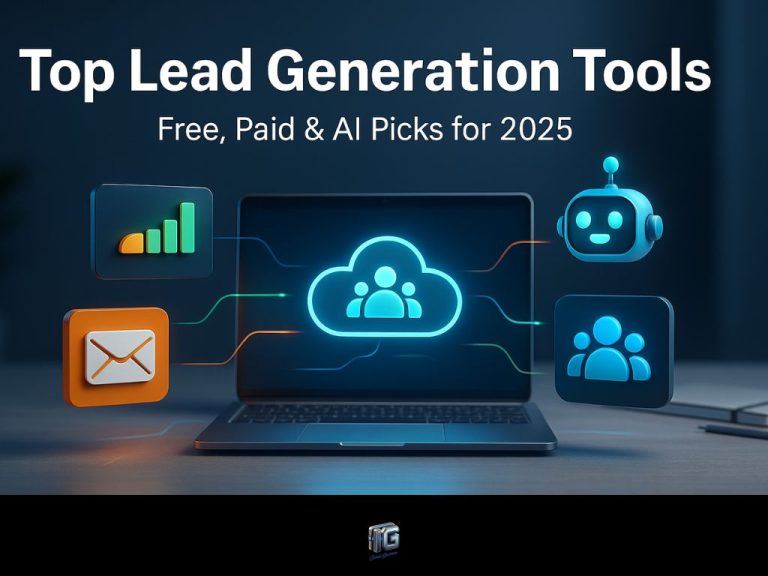
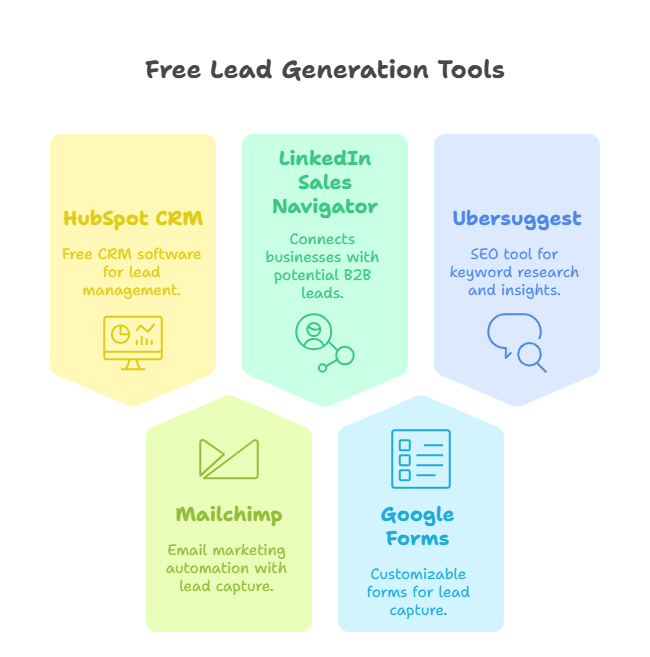
Best Free Lead Generation Tools
Free tools can be deceptively powerful if you know how to unlock their full potential. The secret? Don’t treat them as “limited trials.” Use them like a strategist: stack features, squeeze every automation, and obsess over what actually fills your funnel.
Here’s what separates high-growth marketers from everyone else: They choose a single free tool that matches their unique traffic source, then build repeatable systems before ever paying for an upgrade.
Ready for the shortlist that gets real results without draining your budget?
1. HubSpot CRM
What it does: A full-featured customer relationship management platform with zero entry cost. Capture, organize, and track every lead, deal, and interaction all from a single, intuitive dashboard.
Why it works:
- Instantly capture leads from website forms, live chat, or email no coding required.
- Trigger follow-ups the second a new lead enters your pipeline.
- Track every touchpoint, so no prospect ever “slips through the cracks.”
- Pro move: Use HubSpot’s email templates and snippets to speed up outreach without sounding like a robot.
Who wins here? Solopreneurs, small businesses, and anyone building their first list HubSpot CRM lets you operate like a pro from day one.
2. Mailchimp (Free Plan)
What it does: Launch landing pages, automate welcome sequences, and nurture your list all before you pay a dime.
Why it works:
- Plug-and-play forms embed anywhere, instantly connecting your website or social bio to your mailing list.
- Visual automations make follow-ups brain-dead simple set them up once and let Mailchimp warm up every new lead automatically.
- Segment your audience to send targeted content, even on the free plan.
- Pro move: Use Mailchimp’s built-in analytics to see exactly which forms and emails pull the most conversions then double down.
Perfect for creators, startups, and anyone who wants fast, frictionless list building without tech headaches.
3. Google Forms & Typeform (Freemium)
What it does: Frictionless form builders that let you collect signups, run quizzes, and segment leads all without a developer.
Why it works:
- Create unlimited forms and embed them anywhere on your site, blog, or even your Instagram bio.
- Use logic jumps and custom questions (with Typeform) to segment leads by interest or intent before they ever join your list.
- Pro move: Pair your form with a juicy lead magnet. Instantly deliver the magnet upon submission using Google Drive or an automated email from Mailchimp.
This duo is a must for educators, consultants, and content marketers who want ultra-targeted lead capture on autopilot.
4. Ubersuggest (Free Plan)
What it does: Unleash the power of SEO for free. Find high-intent keywords, content gaps, and backlink opportunities then turn that traffic into leads.
Why it works:
- Discover keywords with proven demand and little competition.
- Analyze top-ranking content, spot weaknesses, and create offers your competitors miss.
- Pro move: Build landing pages around untapped keywords and add an irresistible opt-in this is how organic marketers grow lists without ads.
If you want to generate leads from Google, Ubersuggest is the unfair advantage you need.
5. LinkedIn (Free Account + Search)
What it does: Social selling, audience building, and relationship-driven lead gen all from a standard LinkedIn profile.
Why it works:
- Leverage LinkedIn’s powerful filters to find your exact target audience by industry, job title, or location.
- Post thought-leadership content that attracts inbound leads. Engage directly via comments and DMs no ad spend required.
- Pro move: Offer a free checklist or mini-guide as your profile’s “Featured” link. Every connection request turns into a warm lead.
If you’re B2B or serve professionals, this is a goldmine waiting to be worked.
How to Get the Most from Free Lead Generation Tools
Don’t just “use” these tools, build a system. Map your traffic sources to the right capture tool. Set up basic automations on day one.
Track what’s working, and cut what’s not. Only upgrade once you’re maxing out free capacity and you know exactly what’s holding you back.
Get strategic. Stay lean. Watch your pipeline grow without paying a cent.
🔝 Best Free Lead Generation Tools At a Glance (2025)
| Tool | What It Does Best | Limitation | Ideal User |
|---|---|---|---|
| HubSpot CRM | All-in-one free CRM: capture, track, and manage leads easily. | Feature caps once scaling (automation, advanced reporting). | Solopreneurs & small businesses starting out. |
| Mailchimp (Free Plan) | Email automation + landing pages without cost. | Limited sends, branding on free tier. | Creators & startups wanting fast list building. |
| Google Forms / Typeform | Easy lead capture, quizzes, segmentation. | Limited design & integrations (Google Forms). | Coaches, educators, consultants. |
| Ubersuggest (Free) | SEO keyword research to drive organic leads. | Limited daily searches. | Content marketers on a budget. |
| LinkedIn (Free) | B2B lead gen via organic posting & outreach. | Time-intensive, manual engagement. | B2B service providers. |

Best Paid Lead Generation Tools
Free tools will get you started, but the fastest-growing companies know this: when you invest in the right paid lead generation platform, you buy back your time, multiply your reach, and unlock automations your competitors wish they had.
If you want to stop piecing together spreadsheets and start building scalable systems, here’s where you upgrade. Below are the paid lead gen tools that separate average marketers from deal-closing machines.
1. Apollo.io: B2B Prospecting on Steroids
What it does: Combines an AI-driven contact database with automated outreach, smart workflows, and intent-based targeting.
Why it’s worth every penny:
- Instantly find and connect with decision-makers at your dream clients, not just “leads” from a generic list.
- Automate entire outbound sequences emails, calls, LinkedIn messages so you stay top-of-mind without doing the grunt work.
- Tap into verified email addresses, real-time data enrichment, and deep analytics to prioritize the hottest prospects.
- Pro move: Use Apollo’s filters and triggers to build hyper-targeted “smart lists” for every product line or campaign.
For sales teams, agencies, or anyone running B2B outreach at scale, Apollo turns guesswork into predictable pipeline.
2. ClickFunnels: Funnel Building & Conversion Simplified
What it does: All-in-one platform for building, optimizing, and automating high-converting lead funnels, no coding, no fuss.
Why it’s a marketer’s secret weapon:
- Launch landing pages, sales funnels, and automated follow-ups in hours, not weeks.
- Built-in A/B testing lets you quickly optimize every page for conversions.
- Integrate payments, webinars, and upsells with a few clicks everything you need to move prospects from click to close.
- Pro move: Clone winning funnels from the ClickFunnels Marketplace to shortcut your way to proven results.
For entrepreneurs and growth marketers who want speed, simplicity, and conversion firepower, ClickFunnels is the unfair advantage.
Stop overpaying for marketing tools
get everything in one place.
- All-in-one platform to drive traffic, capture leads, and grow sales.
- Designed for marketers who want more results with less effort.
Claim Your Spot Today
3. Leadfeeder: Turn Anonymous Traffic into Qualified Leads
What it does: Reveals which companies visit your site, even if they never fill out a form giving you a second chance to engage and convert.
Why serious teams rely on it:
- See exactly who’s on your website, what pages they view, and how long they stay unlocking intent signals you can act on today.
- Syncs with your CRM, triggers lead alerts, and helps sales follow up when prospects are hottest.
- Pro move: Set up custom filters to prioritize accounts with the highest buying potential, so your sales team only calls the hottest leads.
For B2B and high-ticket sales, Leadfeeder turns “invisible” web traffic into a living, breathing pipeline.
4. SEMrush: SEO-Driven Lead Generation Engine
What it does: More than an SEO tool SEMrush delivers a competitive edge across keyword research, content strategy, and traffic analysis.
Why it’s a non-negotiable for content-driven brands:
- Discover high-converting keywords and backlink opportunities that bring in ready-to-buy traffic.
- Reverse-engineer competitor strategies to find gaps and fill your funnel with the right prospects.
- Pro move: Use SEMrush’s Content Marketing Toolkit to build pillar pages and cluster content that keep you ranking and converting all year long.
For marketers obsessed with organic growth and content ROI, SEMrush is the ultimate weapon.
5. Unbounce: AI-Enhanced Landing Pages That Convert
What it does: Lets you build, test, and optimize landing pages in minutes, not days with AI-powered copy suggestions and dynamic elements.
Why conversion experts swear by it:
- Pre-built templates + drag-and-drop editor = beautiful, high-converting pages every time.
- A/B and multivariate testing lets you squeeze every drop of value from your traffic.
- Dynamic text replacement matches ad keywords to landing page copy, boosting relevance and conversions.
- Pro move: Use Unbounce’s Smart Traffic feature AI automatically directs each visitor to the highest-converting page variant.
For anyone running paid ads, cold traffic, or launches, Unbounce pays for itself with just a handful of conversions.
How to Win with Paid Lead Generation Tools
Don’t just “set and forget.” Connect your tools: sync CRM data, automate follow-ups, and integrate analytics to track what’s working.
Test ruthlessly. When something works, scale it, double your spend, double your leads. The top lead gen teams don’t have more tools; they build better systems.
If you’re looking to build and optimize a high-converting lead generation funnel, check out our detailed guide on lead generation funnels.
🔝 Best Paid Lead Generation Tools At a Glance (2025)
| Tool | What It Does Best | Limitation | Ideal User |
|---|---|---|---|
| Apollo.io | AI-driven B2B prospecting + automated outreach. | Cost scales with database usage. | Agencies & B2B sales teams. |
| ClickFunnels | Funnel builder + automation all-in-one. | Pricing higher than most landing page tools. | Entrepreneurs & digital marketers. |
| Leadfeeder | Identifies anonymous website visitors & company intent. | Best for B2B, less useful for B2C. | High-ticket B2B businesses. |
| SEMrush | SEO + competitor insights to fuel organic lead growth. | Pricey for beginners. | Content-driven brands. |
| Unbounce | AI-powered landing page builder with Smart Traffic. | Only for landing pages (not full funnels). | Paid ads & launch campaigns. |
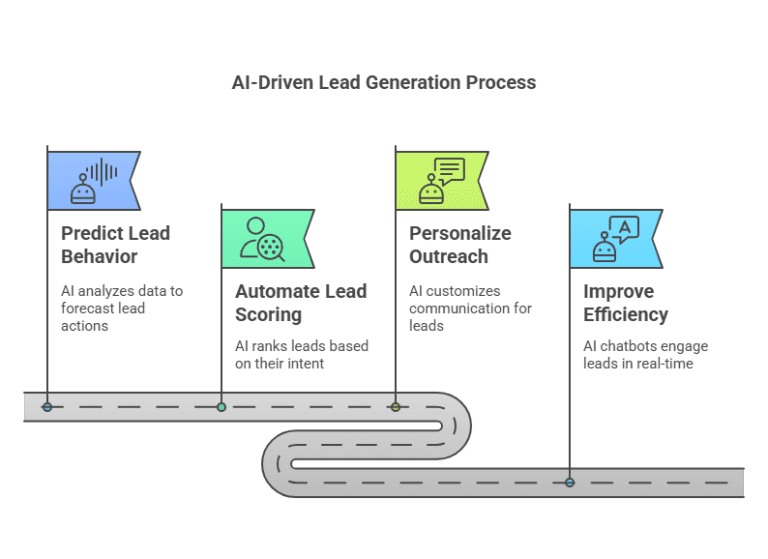
AI Tools That Are Changing Lead Generation in 2025
Think AI tools are just hype? In 2025, the smartest marketers know one truth: if you’re still doing everything manually, you’re getting outrun.
AI isn’t replacing lead generation, it’s amplifying it. The new leaders aren’t working harder, they’re automating smarter, closing faster, and reading intent before their competitors even wake up.
These are the AI-driven platforms quietly powering the fastest-growing pipelines this year and how to use them before your rivals catch on.
1. Drift: Real-Time AI Conversations That Close Deals
What it does: Puts AI chatbots on your site to qualify, nurture, and book meetings 24/7, even while you sleep.
Why it works:
- Instantly engages every visitor with hyper-personalized chat, no human lag.
- Routes hot leads directly to your inbox, calendar, or sales team.
- Uses conversation data to score, segment, and prioritize the leads most likely to convert.
- Pro move: Build custom playbooks so the AI handles FAQs, pre-qualifies leads, and only passes the best prospects to your team.
If you’re in SaaS, services, or high-ticket funnels, Drift transforms your website into a non-stop lead engine.
2. Exceed.ai: Your AI Sales Development Assistant
What it does: Automates back-and-forth email, SMS, and chat conversations to qualify leads and push them toward the next step, no manual chasing.
Why it works:
- Handles objections, follow-ups, and scheduling as if a human SDR were behind every reply.
- Syncs with your CRM so every new lead is tracked, updated, and scored in real time.
- Pro move: Set up conditional flows to “revive” old leads and re-engage cold prospects without ever touching your keyboard.
Use Exceed.ai to free your human reps for only the hottest leads, while the AI nurtures everyone else.
3. ZoomInfo: AI-Powered B2B Prospecting and Intent Tracking
What it does: Combines massive data intelligence with machine learning to surface buyers who are actually ready to say yes.
Why it works:
- Tracks buying signals, company growth, new hires, and other intent clues most tools miss.
- Pushes verified decision-maker contacts straight to your CRM or outreach campaigns.
- Pro move: Use ZoomInfo’s intent data to launch laser-targeted outbound sequences the AI tells you who to contact and when.
For B2B teams, ZoomInfo is like seeing the future of your pipeline before your competition does.
How to Maximize AI in Your Lead Gen Stack
Don’t “set it and forget it.” Train your AI tools using real-world data: import your best leads, tweak workflows, and monitor results weekly.
The secret? Let AI do the heavy lifting then layer in human creativity for the final close. Blend automation and personal touch, and your pipeline scales on autopilot.
If you’re still sending the same email blast to every new lead, your competitors are eating your lunch.
Use AI to get personal, stay fast, and leave manual labor in the dust.
Best AI Lead Generation Tools (2025)
| Tool | What It Does Best | Limitation | Ideal User |
|---|---|---|---|
| Drift | AI chatbots for real-time lead capture & meeting booking. | Setup time + cost. | SaaS, agencies, high-ticket offers. |
| Exceed.ai | Automates email/SMS/chat to qualify & nurture leads. | Requires CRM integration to shine. | Sales teams needing SDR automation. |
| ZoomInfo | AI-powered intent data + verified contacts. | Expensive at scale. | Enterprise & B2B marketers. |
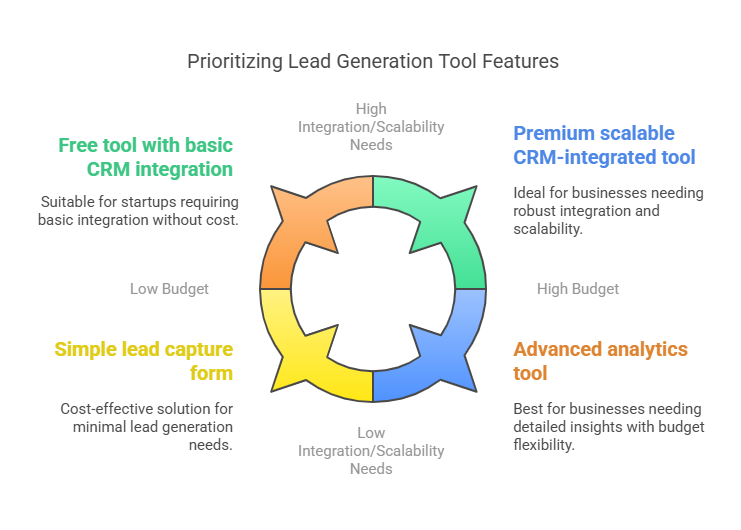
How to Choose the Right Lead Generation Tool
The worst tool? The one you never actually use. With so many shiny platforms competing for your budget, it’s easy to get stuck comparing features while your pipeline runs dry. Stop chasing “best” start chasing “best for you.”
Here’s how smart marketers cut through the noise and stack the deck in their favor:
1. Know Your Business Model Or Burn Your Budget
Are you selling high-ticket services to Fortune 500s, or e-books to side hustlers? Your model decides your stack. B2B?
You need deep prospecting and intent tools, think Apollo.io, Leadfeeder, ZoomInfo. B2C? Speed and simplicity matter, grab ClickFunnels, Unbounce, or Mailchimp.
If you’re running a hybrid model, stack outbound automation with smart CRMs to cover every angle.
2. Map Your Funnel And Attack the Bottleneck
Where are your leads falling off? Traffic, conversion, or follow-up?
- Not enough eyeballs? Focus on SEO and content tools like SEMrush and Ubersuggest.
- Traffic but no conversions? Your landing pages need helpUnbounce, ClickFunnels, or Typeform are your move.
- Leads stalling after sign-up? Automate follow-up and scoring with Mailchimp, Drift, or Exceed.ai. Pro move: Fix the slowest part of your funnel first. Then scale.
3. Pick Tools You’ll Actually Use Not Just Admire
Feature lists don’t fill pipelines. You want software that fits your workflow, your brain, and your budget. Hate design? Grab page builders with templates.
Hate cold outreach? Let AI handle it. Need fast analytics? Use platforms with built-in dashboards. The best stack is the one you deploy, tweak, and outgrow.
4. Start Lean Scale Ruthlessly
You don’t need a $10,000 tech stack on day one. Launch with the minimum set of tools to capture and convert leads.
Once you’ve validated your funnel and know what works, then and only then add automation, integrations, and paid upgrades to multiply results.
The Only Question That Matters:
Does this tool help you attract, qualify, or convert leads better than what you’re doing right now? If the answer isn’t an instant yes, skip it.
The fastest path to ROI isn’t adding more tools. It’s picking the right one, mastering it, and scaling what actually drives growth.
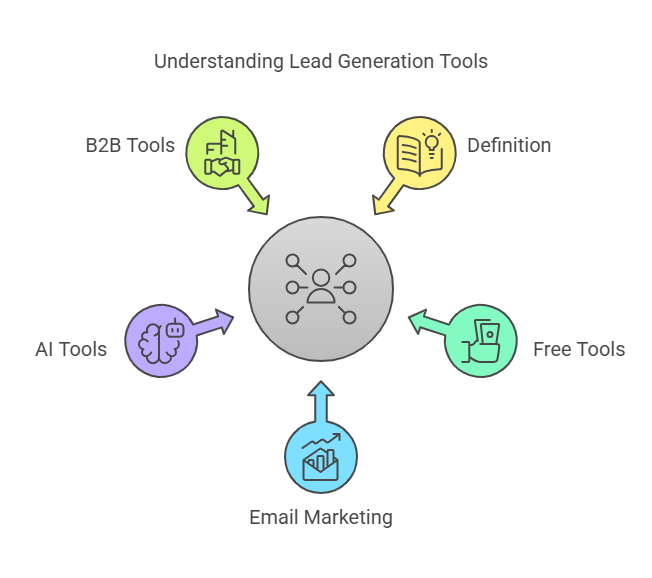
Mistakes to Avoid When Using Lead Generation Tools
Even with the best lead generation tools, most marketers sabotage themselves by making simple but costly mistakes. Avoid these pitfalls if you want your stack to actually generate revenue instead of wasted subscriptions.
Chasing Too Many Tools at Once
The biggest trap is stacking five platforms when you only need two. Complexity kills consistency. Pick one tool per funnel stage and master it before adding more.
Paying Before You Prove
Don’t upgrade to paid plans just because the feature list looks exciting. Max out the free or entry-level version first. Once your pipeline hits the ceiling, then invest in scaling.
Ignoring Integrations
A CRM that doesn’t talk to your email platform or a landing page tool that doesn’t sync with analytics is useless. Always check whether your stack integrates smoothly.
Treating AI as “Set and Forget”
AI lead scoring and chatbots are powerful, but they’re not autopilot magic. Left alone, they misclassify leads or push generic messages. Train them with your data and refine weekly.
Skipping Funnel Tracking
Capturing leads is easy. Converting them is harder. Too many marketers stop at “form fills” without tracking conversion rates, drop-offs, and ROI. If you can’t measure it, you can’t improve it.
Forgetting About Lead Quality
More leads aren’t always better. A bloated list of unqualified prospects drains your time and tools. Always focus on quality over quantity by segmenting and scoring leads.
Relying Solely on Tools Instead of Strategy
Tools amplify strategy, they don’t replace it. Without a clear offer, strong funnel, and consistent follow-up, no platform will save you.
🚨 Mistakes to Avoid - Lead Generation Tools
| Mistake | Why It Hurts | Fix |
|---|---|---|
| Using too many tools at once | Creates complexity, higher costs, and inconsistent execution | Start lean: 1 tool per funnel stage, expand only when needed |
| Paying for upgrades too early | Wastes money before you’ve proven ROI | Max out free or entry-level plans before investing |
| Ignoring integrations | Leads fall through the cracks when systems don’t sync | Choose tools that connect with your CRM, email, and analytics |
| Treating AI as “set and forget” | Poor lead scoring and generic outreach lower conversions | Train AI with your data and refine flows weekly |
| Not tracking funnel performance | You can’t optimize what you don’t measure | Track conversions, drop-offs, and cost per lead |
| Chasing volume over quality | Bloated, unqualified lists waste time and resources | Segment, score, and focus on high-intent leads |
| Relying only on tools (no strategy) | Tools amplify, but they don’t replace a weak funnel | Build a clear offer and follow-up strategy first |
Conclusion: Don’t Let the Wrong Tool Slow You Down
In 2025, the gap between businesses that dominate and those that disappear is simple: speed, focus, and the right stack. The top lead generation tools won’t just save you time they’ll multiply your results, fill your pipeline, and let you scale without the grind.
You don’t need a shelf full of software. You need the right tool for your model, your funnel, and your stage of growth. Start lean. Get proof. When you’re ready to accelerate, upgrade to the platform that eliminates bottlenecks and fuels real momentum.
Don’t settle for guesswork, hype, or endless comparisons. Pick the tool that fits your next goal, master it, and watch your competition wonder how you keep pulling ahead.
Ready for the blueprint behind a high-converting lead gen system?
Read out our Guide to Lead Generation and build a pipeline that runs on autopilot.
Maximize Your Leads and Earnings Without Extra Work
- Create, store, and track lead magnets effortlessly, all from one simple dashboard.
- AI-powered templates help you generate high-converting lead magnets in minutes.
- Boost commissions with built-in branding that turns every lead magnet into a traffic source.
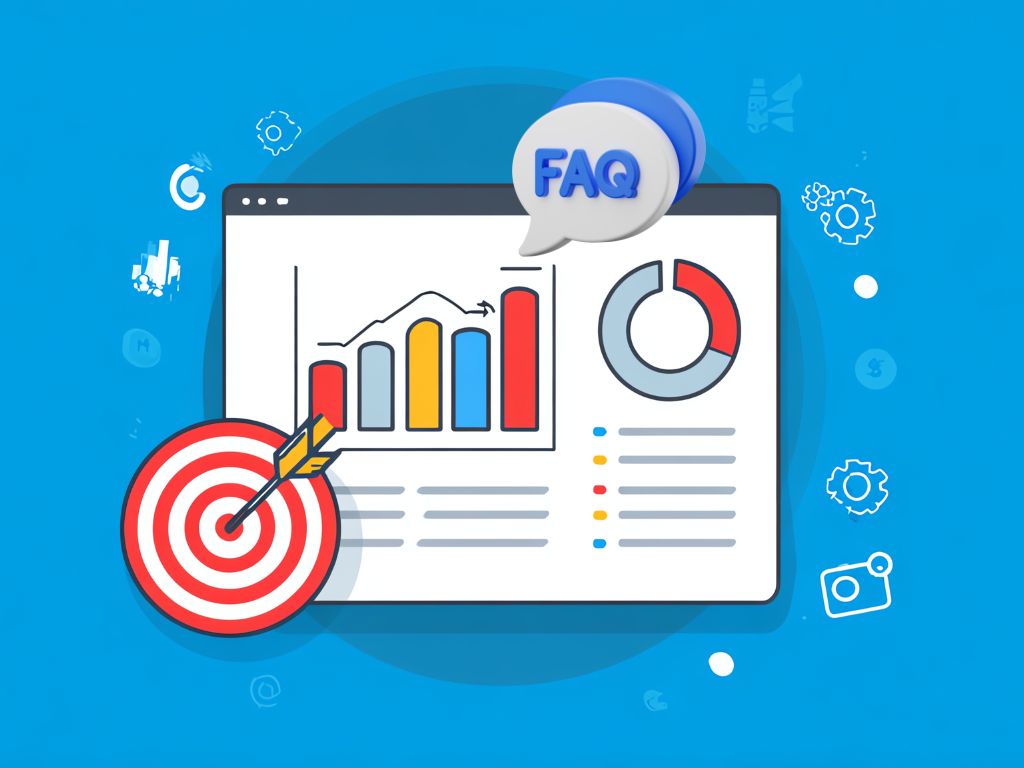
Frequently Asked Questions (FAQs)
What is a lead generation tool?
A lead generation tool is software that helps you attract, capture, and convert potential customers automating everything from email collection to follow-ups. The right tool turns strangers into prospects, prospects into buyers, and buyers into repeat business.
What’s the best lead generation tool for beginners?
Start simple. HubSpot CRM and Mailchimp give you everything you need to capture leads, tag contacts, and send follow-ups without a learning curve or credit card. Get traction here, then upgrade only when you hit their limits.
Are free lead generation tools worth using?
Absolutely, but only if you use them with purpose. Free tools are perfect for testing your funnel, collecting leads, and learning what works. They’ll never scale like paid platforms, but they’re the fastest way to validate your offer and build a list from zero.
What tools work best for B2B lead generation?
B2B demands data and automation. Apollo.io, Leadfeeder, LinkedIn (with a smart profile and content strategy), and ZoomInfo are built to surface decision-makers, track intent, and power high-value outreach. Don’t waste time on “pretty” tools, go where the data is.
How do AI tools help with lead generation?
AI tools remove bottlenecks. They score leads, trigger instant follow-ups, personalize your messaging, and spot the hottest prospects automatically. Tools like Drift, Exceed.ai, and ZoomInfo let you focus on deals that are ready to close, not dead-end leads.
Do I need multiple tools to build a lead generation funnel?
Not always. One robust platform (like ClickFunnels, ConvertKit, or HubSpot) can run your entire funnel if you’re focused. But if you’re targeting multiple channels: SEO, paid, B2B, email, a tight stack of 2–3 focused tools beats trying to force one to do it all.
What’s the biggest mistake people make with lead generation tools?
Chasing features instead of results. More buttons don’t equal more leads. Winners pick tools that solve their single biggest bottleneck, master them, and only add complexity when their funnel is already converting.

2 Comments
Digital Product Ideas: Best Niches & Trending Products for 2025 - Ismel Guerrero. · April 19, 2025 at 2:52 pm
[…] Read our Best AI Lead Generation Tools Guide. […]
Lead Magnet Generator: Creating Irresistible Offers in Minutes - Lead Magnets Creator · June 12, 2025 at 6:23 pm
[…] Check out this Lead Generation Tools Guide. […]